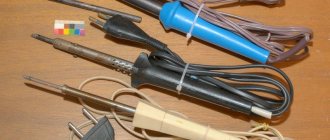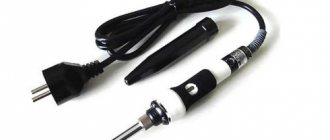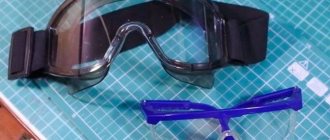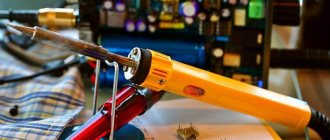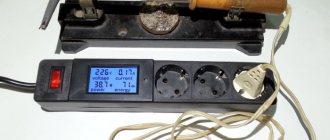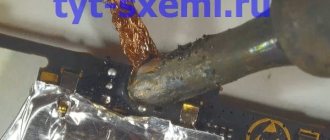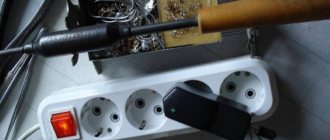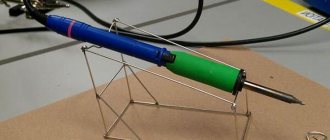There are a large number of synthetic products or folk methods to clean the soldering iron tip. The effectiveness of cleaning depends on which tip is used to solder various surfaces. A distinction is also made between ordinary carbon deposits and chemical oxides. The latter are much more difficult to clean completely. If the soldering is copper, then you can experiment with cleaning. For other alloys (so-called eternal tips), any mechanical stress can lead to damage. You can simply remove the top layer of the alloy; it will no longer be possible to use such a sting.
Electric soldering iron device.
Causes of soot
Beginner radio amateurs often have problems getting to know the eternal soldering iron tips. These tips do not forgive careless treatment, so you need to learn how to properly prepare a soldering iron for work so that soldering is quick and of high quality.
Some beginners or those who are used to working with copper tips make a fatal mistake. They clean the soldering iron tip with sandpaper, files or blades from a stationery knife. This is only true for uncoated copper tips. This method is unacceptable in principle for “eternal” stings.
There is a high risk of damaging the outer layer of the tip (a thin metal alloy), which can lead to cracks and further destruction. In addition, despite its appearance, the soot layer itself does not exceed some microns. So how to clean a soldering iron from such deposits? There are several ways.
What is popularly used to clean stings?
Cleaning the soldering iron tip can be done using sponges.
Products from the store very often do not live up to expectations, so many people use traditional methods of cleaning solder. The list of means used includes many methods. To remove carbon deposits use:
- a variety of sponges - from kitchen sponges to cosmetic sponges, ordinary foam rubber;
- paper, cotton wool and cotton swabs;
- sewing needles, files, metal brushes and attachments, like on drills;
- polishing cloths, emery cloths, scalpels;
- ink erasers (eraser) and much more.
Soldering iron tinning
What is soldering iron tinning? This is when solder is applied to the soldering iron tip, which covers the copper base of the tip so that it does not burn during operation of the soldering iron and is capable of releasing solder.
Copper tips
Tinning should only be done if the tip is copper.
Before heating, copper tips are cleaned either with a file or emery to remove old oxides and burnt surfaces.
Next, the copper tip of the soldering iron is dipped into solder with the addition of rosin (or flux) and thus the soldering iron is tinned and becomes suitable for use.
Unburnt eternal stings
If you have an “eternal tip” with a coating, there is no need to tin it like a copper one.
The main thing is to handle it correctly, clean it on time, and not make gross mistakes.
Although copper tips have better thermal conductivity, over time they begin to lose their shape and burn out. But “eternal tips” have a coating that protects the metal base of the tip from deformation and burnout.
The advantages of an eternal sting are obvious, but not all even experienced radio amateurs want to work with them.
This happens because the “eternal sting” cannot be looked after in the same way as a copper one.
What not to do with eternal stings
For example, it is strictly forbidden to clean unburnt tips from carbon deposits with needle files or sandpaper.
Yes, you will partially remove carbon deposits from air and old solder, but you will damage the tip coating. And over time, it will accept solder worse, or even become completely covered with black oxides.
Synthetic products from the store
It is proposed to combat oxides and carbon deposits using a large number of means. They all have different names, but are basically the same in composition.
There are 3 main ways to clean the tip:
- a chemical substance from the oxidation category or a sting activator;
- Goot BS-2 cleansing paste;
- synthetic sponge for soldering.
The choice of products like oxidal must be approached very carefully. You should familiarize yourself with the composition and decide whether it is suitable for a copper or multi-alloy tip. Too aggressive substances, along with the destruction of the oxide, can also dissolve the top layer of eternal solder.
Soldering iron tip device.
There are also so-called sting activators, which do not clean very well. But their daily use improves wettability and protects the surface from the formation of soot and oxides.
Cleansing pastes are more versatile. They remove carbon deposits very well, but fight oxides a little worse. But they are suitable for any stings. In addition to pastes, there are special boxes with small metal filings into which you need to dip the dirty soldering iron tip to clean it. After this, both carbon deposits and part of the oxide are removed due to a chemical reaction with sawdust.
It must be remembered that any synthetic product must be thoroughly removed after cleaning the surface. Otherwise, it will react with the solder or soldering board, and then the tip may be seriously damaged.
Synthetic sponges, such as Xytronic TIP Cleaner for dry cleaning, help clean the tip mainly from carbon deposits. They are ineffective in the fight against oxides. Many people replace these sponges with ordinary kitchen sponges, but this is not entirely correct. When in contact with a hot soldering iron, such a sponge can smell very unpleasant. This will not happen with store-bought soldering. Store-bought sponges can either be dry-cleaning or need to be dampened before use. This nuance needs to be clarified when purchasing, because buying a wet sponge is a waste of money.
How to clean a soldering iron tip
Let's look at the most popular methods.
The myth about cleaning stings
It is far from the best way to clean the sting using wooden planks. There will be a lot of smoke during the process, and ordinary wood cannot effectively clean the sting from oxides. You can rub a soldering iron on a piece of wood until you turn blue, but it will be of little use. Below we will look at another example of cleaning a tip with a piece of wood, but using a large amount of solder.
Cleaning with damp sponges and cotton rags
So, in order to properly prepare a soldering iron with a permanent or copper tip, you need a sponge to remove solder.
Or a cotton rag moistened with water will do.
Ordinary cotton wool, rolled into a ball, will also work. It removes solder well. And this is all that is needed if there is little carbon deposits on the soldering iron.
Plug in the soldering iron or station and wait until the tip heats up.
By the way, the soldering temperature should not be higher than 300 °C.
If there is old solder on the tip, remove it with a damp sponge or rag.
Moreover, it doesn’t take long to clean, but quickly, in just a couple of movements. And immediately apply fresh solder to the clean tip.
The haste is due to the fact that the surface of the tip is quickly covered with oxides due to air under the influence of the high temperature of the heater.
In the photo you can see a small black dot on the surface of the sting.
These are the first oxides that will gradually turn into large black spots to which the solder will not stick.
Therefore, do not hesitate and immediately add solder to the soldering iron.
If you use a new tip, it will immediately begin to burn, so immediately add fresh solder to the tip. Such sponges and rags remove small deposits from the tip and excess solder. They will not cope with large oxides.
When a wet desoldering sponge won't do the trick
A sponge or rag moistened with water will not help remove carbon deposits from an eternal sting. These surfaces and water, on the contrary, worsen the situation.
Remember an important rule - the soldering iron tip should always be with solder . There is only one exception - when you need to remove excess solder from a board or part. For example, for high-quality use of copper braiding, you need a clean tip without solder.
There should always be solder on the soldering iron. It protects the surface of the tip from oxides while you are not using the soldering iron and are busy with something else. When you need a soldering iron and fresh solder, you simply clean the tip from the old oxidized solder with slag on a sponge or rag moistened with water, and take fresh solder.
If, nevertheless, there is a large deposit on the tip, due to which the surf is not taken, then this deposit can be removed in three ways.
Copper or metal thin shavings
Metal shavings simultaneously remove solder from the surface of the tip and erase the carbon layer without damaging the coating. Such sponges are sold in any smartphone spare parts store, as well as in radio stores and online stores (AliExpress, etc.). A kitchen one can also work, but you need something dense and softer. In addition, it will be worse to clean.
The difference between them is in chip size and quality. Copper shavings remove solder better and gently remove oxides from the tip.
The shavings are very easy to use. It is enough to dip the tip into the shavings and run it several times over the entire area. The oxides and solder will remain there.
Swimming in solder and flux
You can burn off the oxides with a large amount of solder. It is necessary to “bath” the tip in a large amount of solder and flux. In the airless space inside the solder, the oxides will burn and the surface of the tip will be cleaned.
By soldering you can remove a layer of carbon deposits. We make a small bath of solder. You will need a solder rod and flux. Preferably activated (for example, LTI - 120). You can even use regular alcohol rosin. This is in the case of “light” soot, of small size.
Twist several rods of solder into one ball and add flux or soldering acid.
We divide the solder bar into small pieces and pour a little rosin or flux (even if you have solder containing rosin, this is not enough for this case).
And we begin to bathe the tip in solder. If the solder does not melt, then you need to increase the temperature. And do all this on a wooden board or an unnecessary board so that the temperature does not leave the soldering iron and helps remove oxides.
This does not contradict the myth about cleaning the tip with a board. Here we use only a puddle of solder to clean the tip, and a piece of wood only for support. If you use a metal sheet, the tip and solder will quickly cool, giving off all the heat to the metal, which in turn acts as a heat sink.
When doing this work, thoroughly ventilate the room! If the carbon deposits are still difficult to clean off after several attempts, then now you need to use soldering acid. The procedure is the same.
After a couple of minutes, clean the sting with a sponge.
We coat the tip in solder from side to side, without pulling it out, so that the tip is completely enveloped. In a couple of minutes, a small amount of carbon deposits will evaporate, and it will be possible to take a little more fresh solder onto the tip after “bathing”. We leave the soldering iron heated with a drop of water for 10 - 15 minutes.
If oxides remain, repeat the procedure again.
Activators for stings
This method will be needed when everything else fails and nothing else can remove the oxides. If you still need a sting, you can try a sting activator. It is sold in online stores for radio amateurs or on AliExpress.
It is enough to dip the tip into the activators, and it will be clean again. (instructions may vary) But do not abuse this. Activators emit a lot of harmful substances, and why use it constantly when a metal sponge perfectly removes small oxides.
After removing the carbon deposits, you need to apply solder to the tip as soon as possible. even in a few seconds it can burn (if, of course, your soldering iron temperature is over 340 ℃)
Why clean
Regardless of the type and shape of the tool, before starting work, you must clean the soldering iron tip. Over time, deposits accumulate on the working end of the tool, formed during the thermal decomposition of solder and flux. The process is aggravated by the mutual penetration of tin and copper and their thermal diffusion.
A contaminated surface of the tip does not allow soldering to be carried out correctly.
The accumulated combustion products of consumables, which form especially quickly when the soldering iron is left idle in a hot state, interfere with subsequent work. There will be substances in the working area that prevent good adhesion and uniform distribution over the surface. Thorough cleaning avoids problems.
The procedure must also be performed with new soldering irons, because manufacturers, for the purpose of protection, cover the tip with a thin layer of oxides, which is called patina.
A smaller amount of carbon deposits is formed when working with a soldering station that has heating control.
Soldering irons with stainless steel tips do not form deposits at all, but working with them is not familiar or convenient for everyone. It is necessary to choose the right power so that the low thermal conductivity of the tip allows for good soldering.
How to protect your soldering iron tip and increase its service life
To ensure that the tip serves for a long time and with high quality and does not become deformed, adhere to the following recommendations:
- Do not set the temperature on the soldering iron above 350 °C for a long time;
- Try not to solder with soldering acid frequently;
- Do not clean the tip with tools or sandpaper;
- There should always be solder on the soldering iron tip, except in cases where the solder needs to be removed from the board with a soldering iron;
- Do not bend other parts with the soldering iron or hit it on another surface.
Tips for caring for your soldering iron
- Do not leave the soldering iron turned on for a long time without solder or flux on the tip;
- Clean the tip only with a desoldering sponge or a metal sponge, which also removes carbon deposits;
- Do not clean the sting with sandpaper , a knife, or a scalpel. There is a risk of damage to the coating;
- If you solder with acid , be sure to clean the soldering iron after soldering; do not leave it to cool with acid!
Special products for copper tips
To remove carbon deposits, the industry produces a variety of products; extensive practical experience has been accumulated, which is used in modern tip preparation technologies. Approaches to cleaning differ, although, in principle, they come down to two main options for influencing fumes: mechanical and chemical.
Mechanical types of cleaning
Depending on the type of work to be done, you can choose one or another abrasive material. If there is a need to make the tip strictly even and flat, you should take a file. In other cases you can use:
- sandpaper;
- sharpening stones;
- abrasive sponges.
To remove the patina from a new soldering iron, use fine-grit sandpaper. This will be enough to remove a thin production layer. After mechanical cleaning is completed, the tip is treated with rosin or other suitable resin. The rosin composition does a good job of removing plaque consisting of oxides and other impurities.
If desired and possible, you can buy a ready-made device wts-599b. This metal sponge in a special housing is very convenient to use.
Chemical methods
There are possibilities for cleaning the tip with chemical means. You need to choose flux cleaners carefully, after first familiarizing yourself with the metal composition of the tip.
To clean the copper working surfaces of the soldering iron, you can use oxide. Its composition is dominated by ammonium chloride. The sting is heated, placed in a chemical agent and cleansing is observed, which occurs very quickly.
At the end of the procedure, wipe the heater on a sponge or cloth, which should be pre-moistened with water.
Instead of oxide, many craftsmen use a powder with similar properties called ammonia. This is the same ammonium chloride, which removes oxide products well. When heated, it produces caustic gases such as ammonia and hydrogen chloride.
Cleaning the tip with chemicals must be done with good ventilation because caustic fumes of acid and ammonia are released.
The flux-off flux cleaner gives very good results. It is sold in aerosol form and easily removes dense decomposition products of consumables. Any flux layers and remnants of tin-lead solder quickly dissolve. The aerosol must not come into contact with plastics. Other material, for example, a ceramic fixative, will not be damaged by hydrocarbons or esters.
To improve the condition of a contaminated sting, you can buy paste-like activators from the goot series. The function of the active reagent in them is performed by ammonium phosphate mixed with tin powder. The head heated to 300 ℃ must be immersed in the paste and rotated in it. Usually, one dose is enough. If necessary, the procedure can be repeated.
Traditional methods
Inventive craftsmen and amateurs find a way out of the situation in cases where there are no special means nearby. You can take ordinary food grade citric acid, stored in any kitchen, and dip the heated tip into it. The result will not be long in coming - the cleaning is quick and successful.
Some craftsmen try soda, alcohol, aspirin, pharmaceutical glycerin, and other home remedies. The impressions accumulated were different. There are many compounds with a known effect, so it makes no sense to enthusiastically compete in ingenuity.
Cleaning the Blowtorch
The burner of a blowtorch, like the tip of a soldering iron, requires constant care, otherwise it may become completely clogged and not work at all.
The process of dirt accumulation in the nozzle is enhanced when using not very clean fuel. Impurities tend to accumulate together with combustion products. The lamp usually comes with a special needle for cleaning the working hole. If it is not there, the jet can be cleaned with a thin wire.
There is often a need to clean a blowtorch. In this case, treatment can be carried out with aerosol cleaning agents or gasoline. Some craftsmen are able to clean the work area with a cloth soaked in white spirit. The cloth must be completely soaked so that the solvent can remove all the dirt.
Proper preliminary preparation of tools will allow you to do the job efficiently and quickly.
Source

